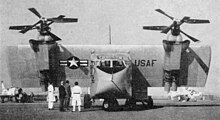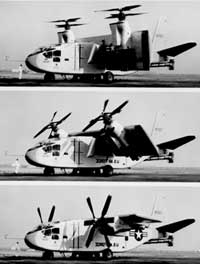User:The Bushranger/X-18
| X-18 | |
|---|---|

| |
| Ground testing the X-18 tiltwing | |
| Role | Experimental prototype |
| Manufacturer | Hiller Aircraft Corporation |
| Designer | Stanley Hiller Jr |
| First flight | 24 November 1959 |
| Status | Aircraft scrapped 1964 |
| Number built | 1 |
| Developed from | Chase YC-122 Avitruc |
The Hiller X-18, also known as the "Propelloplane",[1] was an experimental aircraft built by the Hiller Aircraft Corporation for the United States Air Force. Intended as a testbed for tiltwing technology in the development of practical V/STOL aircraft. Proving troublesome in testing, a near accident resulted in the grounding of the aircraft, and only limited further testing was performed before the program was cancelled.
Design and development
[edit]
Intended as a testbed to prove the feasibility of a large tiltwing aircraft,[2] the X-18 was constructed by Hiller Aircraft Corporation under a contract awarded during 1956.[3] The first large aircraft to make use of the tiltwing concept,[4] , and only the second tiltwing aircraft built in the United States,[3] the X-18 made extensive use of parts from existing aircraft in its construction, with the aircraft's fuselage being that of a Chase YC-122,[2] the engines and propellers being sourced from the Navy program that had produced the Convair XFY and Lockheed XFV programs[2] and fitted to a newly designed wing.[3]
In addition to its twin turboprops, a small turbojet engine was mounded inside the aircraft's cargo hold, with its exhaust ducted under the tail to assist in pitch control at low speed.[citation needed]
Operational history
[edit]
The X-18 conducted its maiden flight on November 20, 1959[2] from Edwards Air Force Base,[citation needed] and flight testing quickly proved that the aircraft suffered from a number of significant issues. The aircraft proved to be susceptible to wind gusts when the wing was rotated, its surface acting like a sail.[citation needed] In addition, the turboprop engines were not cross-linked, so the failure of one engine when in vertical flight mode would inevitably result in a crash.[citation needed] In addition, altitude and roll control authority were insufficient when in the hover.[citation needed]
On the 20th and final flight in July 1961,[2] the X-18 suffered a failure in its propeller pitch controls while attempting to convert to a hover at 10,000 feet (3,000 m), and the aircraft entered a spin.[citation needed] The aircraft's crew was able to regain control and successfully landed,[citation needed] but the X-18 never flew again,[citation needed] having never made a full conversion to vertical flight.[5]
Despite this, ground testing of the tiltwing concepts continued.[citation needed] Eventually a VTOL Test Stand was constructed, on which the X-18's vertical takeoff and landing and hover control was to be tested.[citation needed] One engine run was successfully conducted to the full 15-foot wheel height on the test stand; however, the program was cancelled on January 18, 1964 before further testing could be conducted,[citation needed] and the X-18 was cut up for scrap.[2]
Lessons learned
[edit]Despite its failure, the X-18 program did contribute to the knowledge of the problems faced in vertical flight, especially when using the tiltwing concept; these lessons included the fact that cross-shafting between the engines was mandatory in order to avoid loss of control in the event of an engine failure, while direct propeller pitch control was mandatory for precise height and lateral control during VTOL and hover.[6] This knowledge was employed in the successful development and flight tests of the LTV XC-142A a larger and more successful tilt-wing VSTOL transport.[7]
Specifications (X-18)
[edit]
| This aircraft article is missing some (or all) of its specifications. If you have a source, you can help Wikipedia by adding them. |
General characteristics
- Crew: 2-3
- Length: 63 ft 0 in (19.2 m)
- Wingspan: 48 ft 0 in (14.6 m)
- Height: 24 ft 7 in (7.5 m)
- Empty weight: 26,786 lb (12,150 kg)
- Max takeoff weight: 33,000 lb (14,850 kg)
- Powerplant: 1 × Westinghouse J34 turbojet engine for pitch control, 3,400 lbf (15 kN) thrust
- Powerplant: 2 × Allison T40-A-14 turboprop engines, 5,500 hp (4,100 kW) each
Performance
- Maximum speed: 253 mph (407 km/h, 220 kn)
- Service ceiling: 35,300 ft (10,800 m)Props 4.8m diameter
See also
[edit]Related development
Aircraft of comparable role, configuration, and era
Related lists
References
[edit]- Notes
- Bibliography
- Jenkins, Dennis R. (2003). American X-Vehicles: An Inventory - X-1 to X-50 (PDF). Monographs in Aerospace History. Vol. 31 (Centennial of Flight ed.). Washington, DC: NASA History Office. NASA SP-2003-4531. Retrieved 2010-12-03.
{{cite book}}: Unknown parameter|coauthors=ignored (|author=suggested) (help); Unknown parameter|month=ignored (help) - Leishman, J. Gordon (2006). Principles of Helicopter Aerodynamics. New York: Cambridge University Press. ISBN 0-521-85860-7.
- Miller, Ron (2007). Extreme Aircraft. Irvington, NY: Hydra Publishing. ISBN 978-0-06-089141-1. Retrieved 2010-12-03.
- Nichols, J.B. (1990). The Hiller X-18 Experimental Aircraft - Lessons Learned. AIAA Paper 90-3203.
- Swanborough, Gordon (1964). Vertical Flight Aircraft of the World. London: Temple Press. ASIN B0000CM58C.
External links
[edit]
